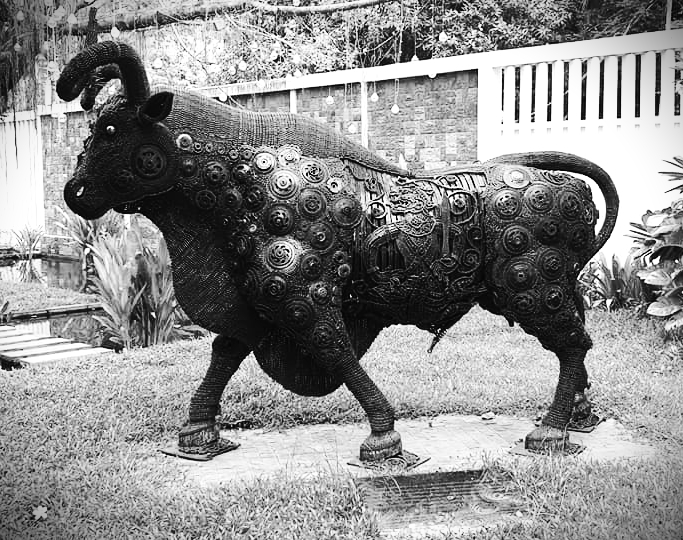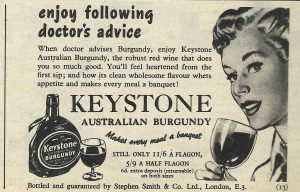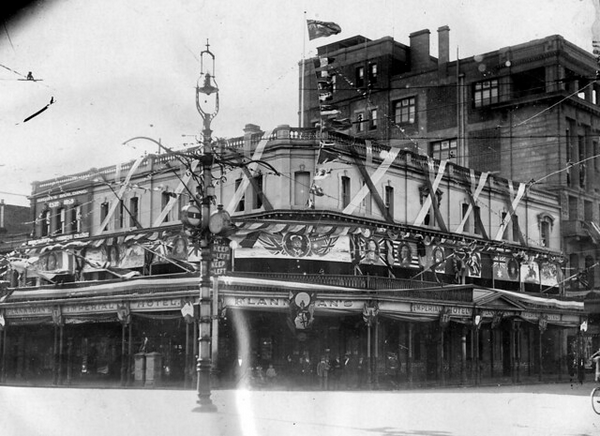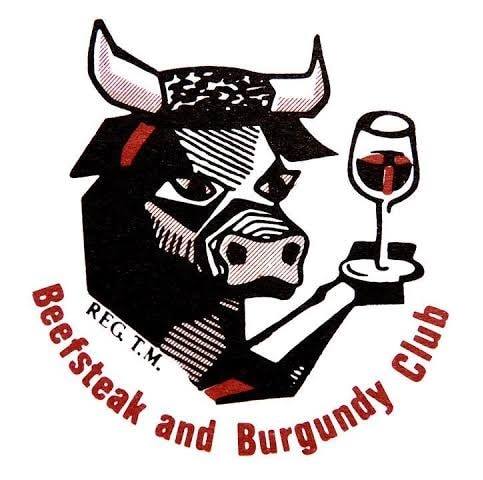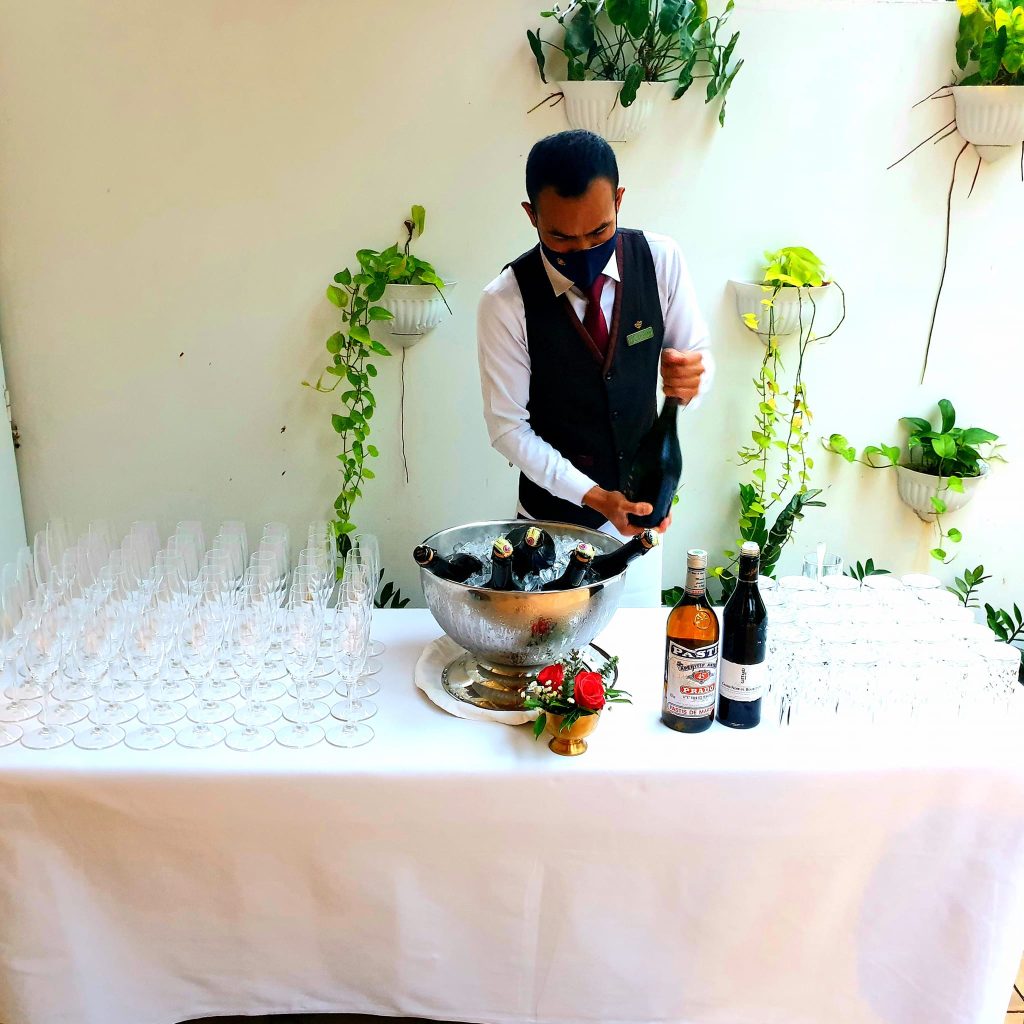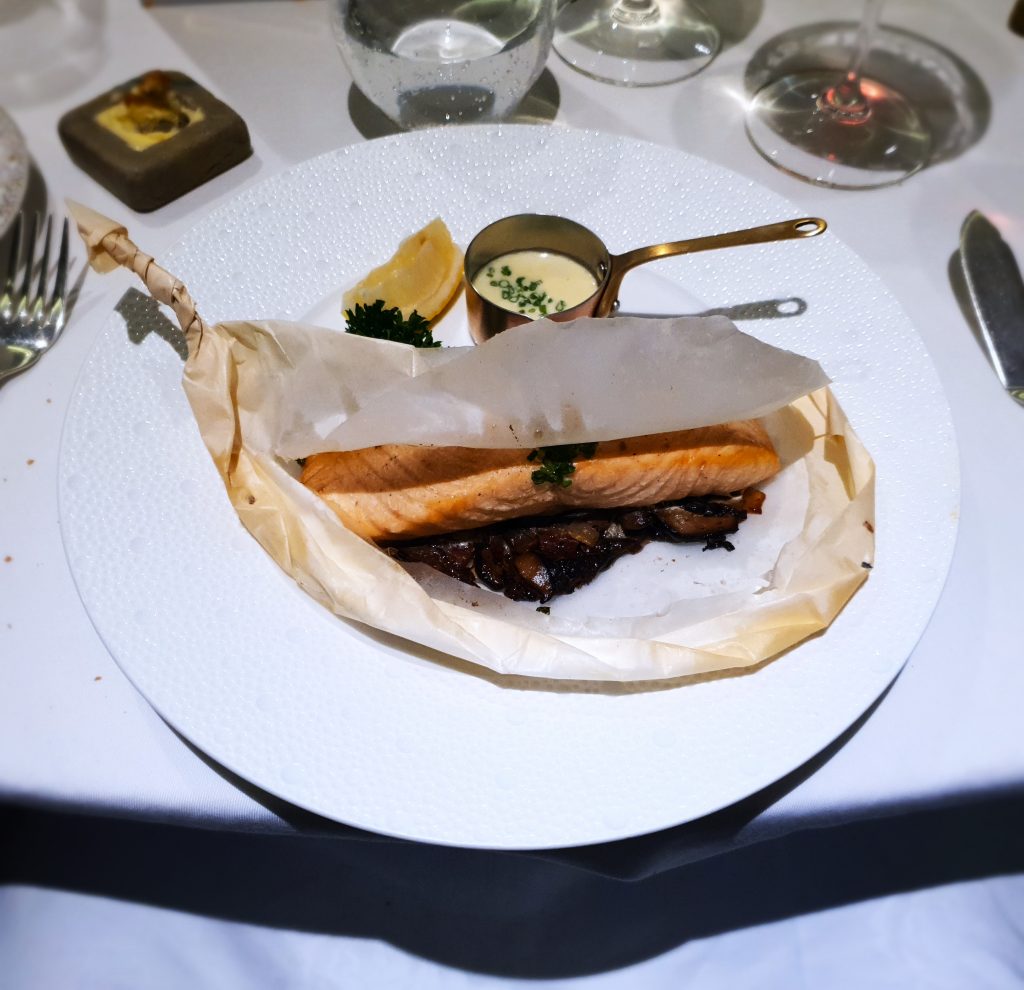A list of the requirements to live a happy life:
Freedom
Self Sufficiency
Friendship
Thought
Wine
Bread & Cheese
-Epicurus, (#Note: Epicurus was an avowed teetotal, the author here has substituted water with wine)
Epicurus
The famous Greek philosopher Epicurus reminds us that we replace emotional needs with commercial wants.
“Why then, if expensive things cannot bring us remarkable joy, are we so powerfully drawn to them? Because of an error similar to that of a migraine sufferer who drills a whole in the side of their skull: because expensive objects can feel like plausible solutions to needs that we don’t fully understand.
Objects mimic in a material dimension what we require in a psychological one. We need to rearrange our minds but are lured to new shelves. We buy a cashmere cardigan as a substitute for the counsel of friends.
We are not solely to blame for our confusions. Our weak understanding of our needs is aggravated by what Epicurus termed the ‘idle opinions’ of those around us, which do not reflect the natural hierarchy of our needs, emphasizing luxury and riches, seldom friendship, freedom, and thought. The prevalence of idle opinion is no coincidence. It is in the interests of commercial enterprises to skew the hierarchy of our needs, to promote a material vision of the good and downplay an unsaleable one.
And the way we are enticed is through the sly association of superfluous objects with our own forgotten needs.
It may be a ‘Jeep’ we end up buying but it was –for Epicurus- freedom we were looking for.
It may be the aperitif we purchase but it was –for Epicurus- friendship we were after.
It may be the new bathing salts and oils we acquire but it was –for Epicurus- thought that would have brought us calm.”
Alain de Botton –The Consolations of Philosophy
For most of us in the developed world, eating is no longer a question of survival it is something that has transcended mere sustenance. Food is traditional, cultural, emotional, it is part of who we are, where we come from, and how we wish to live. As the French critic, epicurean, and gastronome Jean Anthelme Brillat-Savarin, (1755-1826) once said:
“Tell me what you eat, and I shall tell you what you are”.
What people eat can inform us about where they come from geographically, socio-economically, religiously, or even philosophically.
We come together over food, and often it is the very act of sharing food itself that brings us together; eating is communal and community, we commune with family and with friends at mealtime, we talk about our lives, we foment ideas, participate in society; we come to appreciate and at times celebrate the food, the wine and the company in front of us.
Breaking bread, eating with someone is intimate, it is sharing that which sustains us, it is caring about the person you are with, it is a moment to be cherished and to take into your heart.
We choose what we eat, how much we eat, and who we eat it with, and this, in turn, creates who we are in both a physical, (health) and a spiritual, (psychological and emotional) sense.
Post War Australia saw a nation rattled by the prospects of invasion, a once introspective country -now it was ready and willing to be more heuristic and open-minded. Although a federation since 1901, Australia’s non-indigenous population was almost exclusively British and for all intents and purposes, the young nation considered itself to be merely no more than part of the ‘Empire’, an extension of the mother country.
Two world wars in only 25 years and an all-conquering invader on its doorstep, one that had bombed a city on Australian soil and sent submarines into the largest harbor of its most populist city, soon changed its approach to nationhood. Population growth was seen as vital to the future defense of the country and immigration was opened up for the very first time; ‘Populate or Perish’ was the political catchphrase.
At the beginning of the second world war, the official Australian population stood at just seven million people and just 7.4 million six years later, at the end of the war. By the end of the 1960s, that figure had reached over 12.6 million, and by 1976 the population had doubled from post-war figures. This brought a dramatic change in the population mix, in its thinking, its culture, habits, and -along with a booming economy- a dramatic change in the national diet.
Australian Culinaria was about to embark on a journey of great discovery and transformation, that began with southern European migration in the 50s and 60s, followed by Asian migration in the 70s and 80s, and evolved into a sophisticated, cosmopolitan, and wholly adventurous outlook on food by the turn of the century. Today, Australia has a population of just under 26 million people.
I was raised in a post-colonial, post-world-war, 1960’s Australian household that was broken from an early age. The country was experiencing a comprehensive transformation of its population through immigration, in response to vulnerabilities exposed during the second world war, it was still involved in the American war in Vietnam.
This brought with it a whole new world of food, ingredients, and dishes -that would continue to be introduced to the country for the next thirty years- transforming our diet, our palate, and our identity.
My own mother was just seventeen when I was born in 64, both she and my father were weaned on a diet of ‘meat and three veg’ as it would become known. This was a hangover from the days of empire and the last clinging to what remained of the England of many years, ancestors, and generations gone by.
A meat protein, (usually beef, lamb, chicken or pork, very occasionally fish) was the main ingredient, whether served as cuts roasted, in a stew or in sausages was entirely flexible. Meats could be grilled, fried, or barbecued and this also didn’t seem to matter; being comprehensively overcooked seemingly the only immutable rule. The meat would be served with three vegetables of different colours, boiled until they no longer had any semblance of flavour or texture left in them whatsoever. The entire dish was then smothered in store-bought tomato sauce and packet gravy; as if they were some form of life-support, going to work on something that simply had nothing left to give.
These culinary traditions were passed on from my grandparents who were victims of the great depression. Having survived two world wars, it was the depression that stayed with them. I remember my grandfather telling me that at one point he was the only male in his street with a job, ‘the women didn’t go to work back then’, other men would leave their wives and children at home to go off in search of work, sometimes never to be seen or heard from again.
My grandparents would scrimp and scrounge and fret over money for the rest of their lives. Eating for them was not about flavour, it was about saving money at any cost. I remember my grandfather would stuff bulky two-liter cartons of milk into the door of the fridge, even though they didn’t quite fit properly and had to be sort of crushed in, this was stubbornly done because it was a couple of cents cheaper to buy a two-litre carton than two one-liter cartons, which would have fitted in with ease. The result was a lot of regular crying over spilled milk! My grandfather would also pour over the weekly shopping catalogs, working out where all the best specials were, and it was a long-running family joke that he would expend $10 in petrol to save $2 on shopping.
By the time I was eight she had gone, for my mother, it was leave or have a nervous breakdown. She’d never known adut life outside of a single romantic relationship she started when she was just 13 or 14 years old. Living in a new home on the outskirts of the city, out beyond its infrastructure, no license to drive let alone a car, no public transport, no friends to call, home alone all day. The Australian dream soon began to feel like a prison sentence; she just up and fled. I despised her for that for much of my younger life, way back when we are young and free and sprinting across the surface of life’s ocean without pausing to give it enough thought.
Later, in the middle years, when you are beginning to wade into the deeper currents and find yourself getting caught up in the reeds, cut on the coral, I leaned on her a bit, I figured she owed me plenty.
It was only much, much later, when we are older and begin to dive deeply into our oceans in search of meaning, that I began to understand, and in the end, I realized that she couldn’t have stayed and I let go of the heavy, smoothly polished stone I had buried deep inside of me, and I think it finally set us both free. However, she couldn’t cook back then and she can barely cook now.
My father was no villain in this, he was and remains a good man, to me he seemed -back then- to be a man of the 50s thrown into the 60s and 70s, which were a time of tumultuous change. After she left, us three kids (I was the oldest) were sent off to live with different relatives for a year, as the ground under my father’s feet more than shifted, it totally disappeared. Once he regained his footing he brought us all home again, and then proceeded to raise us alone as a working father, it was tough, we barely made it through, eating was just part of surviving. By the time I was one year younger than my mother was when she left, I’d also had enough and up and went too.
After a few years of floating on life’s tides and hurling myself at rocky coastlines, I entered the food and beverage industry, at a time of a very different national palate in Australia and a culinary landscape unrecognizable to that of my parents.
Thanks to European and Asian immigration, Australia was a much more multicultural place, its cities cosmopolitan and with a keen interest in ingredients, both local and imported, and the possibilities for a new, representative, and truly Australian gastronomy. I launched myself into this world, embraced it, and fell in love with a whole new life.
I remember inviting my family over for dinner one evening, laying out a spread of ingredients I’d come to love and share, from memory it was mostly antipasti, pasta, salumi, formaggio, insalata, and lots of nice vino. I soon realized that my family was standing around the table simply staring dumbfounded at what was laid out in front of them, vaguely familiar to them as food but, completely alien in name, flavour, or even etiquette as to how to go about eating it. As usual, it was my father who saved the day, by making an impassioned plea for everyone to appreciate how worldly-wise his children had become and urged us all to just dig in, to which everyone thankfully did.
Soon, I landed a job at a fine wine boutique in Melbourne’s most affluent inner suburb, a family-owned store with a long tradition of offering the finest wines from France, Italy, Australia, and the world to the finest tables of the city’s upper classes.
It was not as if I had finally found my calling, or anything as ridiculous as that, I had seen a way out, a way upward and I grabbed it and held on tight and made sure I wanted it more than anyone else and that I worked harder than everyone else to make sure I succeeded. It changed my life, it taught me to enjoy great food, great wine, and the marriage of the two, it introduced me to the world’s great cuisines, the art of the table, the art of conversation, of being a part of something and of a life worth living.
The wine industry would lead me to South Australia working in wineries, and then to travel around the world; more great wines, more great gastronomy. I moved overseas permanently over 20 years ago. I wrote columns, papers, and eventually books on food and wine.
Fourteen years ago I moved to Cambodia, I met a woman who told me a story about starvation in the villages, and how no matter what scant ingredients her mother had, even if it was only some broken rice and prahok, she could infuse it with her love to create something incredibly delicious, as if by some sort of magic. Her mother’s cooking filled her stomach and her heart with so much joy that she swelled to bursting point, knowing how much her mother loved her and would always take care of her. I turned away and I wept and the tears just came and could not be stopped.
A few years ago my mother came to visit me in Cambodia and I took her to my wife’s village, to meet my new family.
In the early 1950s, a few members of the South Australian wine industry would regularly gather on a Friday for lunch.
It soon became custom to bring a bottle of wine ‘masked’ in a paper bag and served ‘blind’ to get some honest feedback from one’s industry peers. Of course, this was not meant to be too rigorous an examination and for decades many recalled with great mirth the time Tom Hardy put on the same wine, masked as ‘Red Number 1’ and ‘Red Number 2’ and then listened with straight-faced glee as his colleagues expended a great deal of oxygen and vocabulary pointing out the many differences in the two wines!
Ray Drew was chief accountant at Hardy’s winery at the time, and one of the original members of the informal ‘lunch group’. In an ‘oral history’ interview donated to the State Library of South Australia, Drew recalled the camaraderie and conviviality of the time:
“I would say that nearly everybody at Hardys—the management team—would go out and have their bottle of table wine for lunch. And I think that’s where wine and food clubs first became an interesting factor in Australia.
For instance, in Adelaide, the wine industry gathered at the Imperial Hotel every Friday for luncheons, and other diners would see this industry table drinking their wines, discussing wines, and became interested. And the Bacchus Club in Adelaide soon started up and hundreds of people were interested in the pairing of wine with food.
This would be in the early 1950’s, you can say the immediate postwar years. And slowly developed as time passed.
The Beefsteak and Burgundy Club, for instance, of which I was fortunate enough to be one of the founding eight, actually started at the Imperial Hotel. And Des Leahy, the then owner/proprietor of the hotel, would buy the prizewinning carcasses in beef competitions, and hang them for several weeks, and then serve them at these Beefsteak and Burgundy Club dinners.
I think that’s part of the reason the name, Beefsteak, became synonymous with the Beefsteak and Burgundy Clubs. (Burgundy was the name given to the lighter, medium-bodied reds consumed over lunch back in those days, as opposed to the full-bodied ‘Clarets’ one consumed with dinner.)
And, yes, food played a tremendous part. We not only discussed wines, we discussed food, because in my opinion wine can only complement food. It can’t go the other way around.”
The Imperial Hotel had a long narrow dining room, with a slightly raised dais at one end, from which dinners could both observe and be observed. One day in early 1954 one of this informal group of wine industry regulars observed to a young winemaker at the lunch that, other diners were observing them with interest and envy, because of their obvious enjoyment.
He thought that they should form a club so that others from outside the industry could participate. They soon agreed to gather a group of like-minded individuals to see if a club could be formed and on the 1st of April, 1954 that first official gathering agreed that a club should be formed and they would be its inaugural members. This meeting involved 8 people, now known as the First Eight.
Dick Clark set about ensuring the club was established. He came up with the name – the Beefsteak and Burgundy Club – and with the aid of Jim Redman, a stipendiary magistrate, he wrote the constitution of the club. The meeting to formally establish the new Beefsteak and Burgundy Club was held at 89 Currie Street Adelaide on Monday 9 August 1954. Present were Richard (Dick) Clark, David Crosby, George Fairbrother, David (Dave) Cleland, and Ray Drew. The other First Eight members were: Tom Hardy, Bob Clampett, and Jack Edwards.
The meeting resolved that a club be formed with the name to be registered under the Business Names Act as the Beefsteak and Burgundy Club. It was further resolved that a constitution and rules put to the meeting be adopted; that a bank account for the Club be opened; and that the Secretary be authorised to purchase stationery to enable minutes, accounts, and records of the Club’s members to be kept.
The stated Objects in the constitution of the club were listed as being:
- To promote good fellowship and goodwill amongst all sections of the business community;
- To aid in this object the club shall hold social and other functions at which good food and good wines shall be temperately served;
- In furtherance of these objects, the committee for the time being may authorize the formation of affiliated clubs with similar ideals and constitution on such terms and conditions as the committee may direct.
The meeting also decided that the first official function of the Club would be a luncheon held at the Ambassadors Hotel on Monday 30 August 1954.
Following the luncheon at the Ambassadors Hotel, to which each of the First Eight invited a guest, the membership doubled.
 The first Branch Charter was given to Brighton, located in an Adelaide seaside suburb. It was quickly followed by Lockleys, Burnside, and Edwardstown, all suburbs of Adelaide, and then Angas, which met in the city of Adelaide.
The first Branch Charter was given to Brighton, located in an Adelaide seaside suburb. It was quickly followed by Lockleys, Burnside, and Edwardstown, all suburbs of Adelaide, and then Angas, which met in the city of Adelaide.
Nagambie, a small Victorian country town, was the first interstate Branch Club formed, with Charter 6, followed closely by Sydney with Charter 7. Hobart became Club Number 13, Perth 14, Brisbane 17, and Melbourne 18.
The first club outside Australia was the Port Moresby Club in Papua-New Guinea, which received Charter 40 on 12 November 1962. Not unexpectedly, because of the Australian trade presence there, the next club formed outside Australia was the London Club (55).
 The formation of the London Club in 1964 was considered a landmark in the history of Beefsteak and Burgundy, so much so that the Charter should be presented by someone whose long service would allow them to represent all other Clubs.
The formation of the London Club in 1964 was considered a landmark in the history of Beefsteak and Burgundy, so much so that the Charter should be presented by someone whose long service would allow them to represent all other Clubs.
The natural choice was George Fairbrother, the Wine master for The Club, and this idea was so well received that members throughout Australia set up a fund to help pay George’s expenses.
On 13 July 1966 charters were presented simultaneously in the national capitals of Australia (Canberra, Club Number 59) and New Zealand (Wellington, Club Number 60).
 In 2002, the first chapter in Thailand was formed, and after a couple of the founding members of this chapter moved to Cambodia, Chapter 265 in Phnom Penh was founded in 2010.
In 2002, the first chapter in Thailand was formed, and after a couple of the founding members of this chapter moved to Cambodia, Chapter 265 in Phnom Penh was founded in 2010.
As the Beefsteak and Burgundy Club approaches its 70-year birthday, it has grown into a worldwide movement of nearly 5,000 members over approximately 200 active chapters, 30 of which are overseas.
In Cambodia the Beefsteak & Burgundy Club is Chapter 265, it meets on the last Friday of every month for a dinner of five or six courses -paired with wines- at a different restaurant each month.
The club enjoys strong support from the expatriate community and is also well represented by the local Cambodian community and returnee Cambodians -some of whom were born overseas to Cambodian parents.
 The emphasis is strongly based around creating an exceptional degustation of fine food and fine wine and the appropriate pairing of these two components, in order to enhance the culinary experience. There is no place for pretension and little protocol or ceremony, all are welcome and hospitable camaraderie is the only call to order.
The emphasis is strongly based around creating an exceptional degustation of fine food and fine wine and the appropriate pairing of these two components, in order to enhance the culinary experience. There is no place for pretension and little protocol or ceremony, all are welcome and hospitable camaraderie is the only call to order.
If you want to get to know somebody eat with them; when we eat we disengage from the combat of daily life, we disarm ourselves of our arsenal of defenses and become engaged in the moment, we unburden ourselves awash in aromas, tastes, textures -at ease and enjoying the company and conversation.
Topaz is a gemstone, usually, (but not exclusively) the colour of Amontillado sherry, or the saffron robes of a wandering monk. In Phnom Penh, it is the name of a French restaurant that has been the jewel in the city’s culinary crown for over two decades. In a country famous for its ancient wats, shrines, and temples, Topaz is a modern-day place of worship, a place dedicated to the French culinary arts, where gourmands and gastronomes come to enjoy and pay homage to the finest French fine dining in the Kingdom.
The Dinner
At 6pm on the 25th of February 2022, chapter 265 of the International Beefsteak & Burgundy Club met at Topaz for a degustation menu paired with French wines. Thirty-five members were in attendance, a number dictated by current pandemic protocols.
The evening commenced on the terrace adjacent to the garden, behind the main dining hall. This is a welcoming and tranquil setting, impressive in a city challenged for green spaces; with an ancient Banyan tree surrounded by a reflective pond, an immaculate lawn, and verdant foliage, all closely guarded by the large and imposing steel sculpture of a Bull the colour of gun-metal.
Guests were welcomed with the choice of a Kir Royale, (Cassis and Sparkling wine) or a traditional pastis aperitif, dinner would take place in the adjoining private rooms known as ‘The Bordeaux’ and ‘The Burgundy’ opened out to form one large dining space. Sometime after the hour, guests were invited inside to take their seats; welcome speeches and preliminaries out of the way and having already read the impressive menu, guests were licking their lips with anticipation. Dinner at Topaz is always special however, a degustation of this magnitude promised to be a culinary highlight and a fitting way to ring in the vernal equinox, having just put another malevolent ‘Covid’ winter behind us.
The first course was a Veloute de Champignons Sauvages en Croute: a mushroom cappuccino under a golden crust of pastry, which was paired with a Moulin de Gassac Chardonnay from Herault.
The dish had a lovely concentration of flavours without being cloying, it was both rich and yet airy, intensely delicious, and beautifully balanced. The wine was a lighter, fresher style Chardonnay with clean fruit of green fig, citrus, and a touch of melon, backed up by a refreshing brace of citrus and mineral acidity. We were certainly off to a very good start.
This was followed by Salmon en Papillote Facon Alain Darc: parchment wrapped salmon with cepes and ham, paired to a Trimbach Pinot Noir from Alsace.
The Salmon was absolute perfection, tender and moist, the rich flavours of the flesh juicy, rich and enticing, the delightful fatty amino and umami textures, slippery and creamy on the palate, the cepes and ham adding delightful bookends of complexity to a wonderful dish. The wine was old-school Alsace Pinot noir, plenty of ripe fruit in the wild strawberry spectrum with wet stone acidity, fine but persistent tannin, and a lick of old barrel character on the finish, great length, rustic charm, and a wonderful pairing.
 Then it was time to revive the palate with a Sorbet Pomme Vert et Calvados: green apple sorbet in a little bath of Calvados. A lively and exceptional interlude with bright alcohol and tingling fruit acidity that cleansed, revived, and teased out the palate, preparing it for the rich culinary treasures to follow.
Then it was time to revive the palate with a Sorbet Pomme Vert et Calvados: green apple sorbet in a little bath of Calvados. A lively and exceptional interlude with bright alcohol and tingling fruit acidity that cleansed, revived, and teased out the palate, preparing it for the rich culinary treasures to follow.
The Main course was an Entrecote de la Boucherie Nivernaise a la Bordelaise: a magnificent beef steak from the famed artisan Butchers of Nivernaise in Paris, this was paired with a Chateau Roc de Boisseaux, Saint Emilion, Grand Cru 2012. The beef was rich, juicy, and impeccably tender, yet with something there to get your teeth into and enjoy, some texture to go with the flavour, the latter further enhanced with the act of mastication. A prized piece of beef befitting of a club that bears the term ‘Beefsteak’ in its name. The wine was drinking beautifully well as a decade-old Saint Emilion, loads of black and red currents, prune and blueberries with a hint of vanilla, a touch of bramble, and a whiff of sweaty leather. The fine, barely perceptible tannins work up their magic on the rich fatty elements of the beef. A great dish and a charmed pairing.
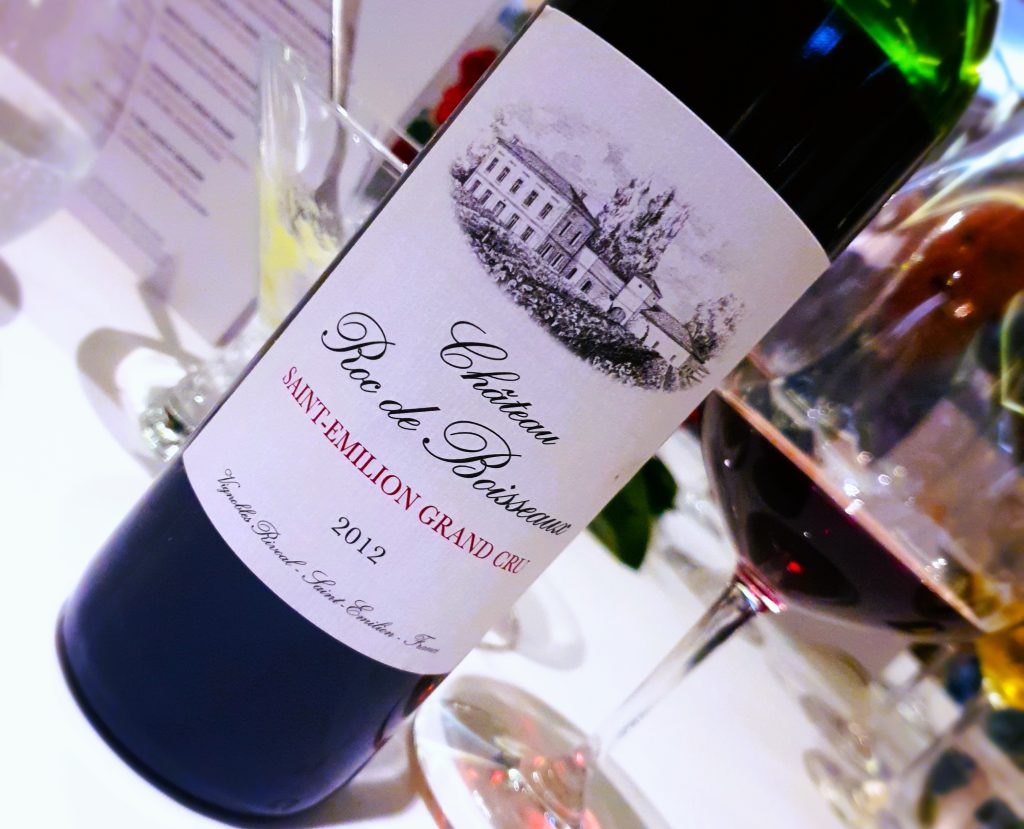 This course was quickly followed by Salade de Mesclun a la Vinaigrette Aux Noix: a mesclun salad with a walnut dressing, this provided a little leafage and roughage to go with the proteins and balance out the meal. The herbage was crisp and fresh, the dressing, sublime.
This course was quickly followed by Salade de Mesclun a la Vinaigrette Aux Noix: a mesclun salad with a walnut dressing, this provided a little leafage and roughage to go with the proteins and balance out the meal. The herbage was crisp and fresh, the dressing, sublime.
Then it was the cheese course, a Brie de Meaux a la Truffe Noir d’Hiver Fraiche: which is to say a Brie from Meaux, with fresh black winter truffles. Again paired with the Chateau Roc de Boisseaux, Saint Emilion Grand Cru. A highlight in a menu of many highlights, this was an exceptional cheese course, a magnificent, creamy, slightly nutty brie wrapped around divine fresh truffle, offering up all of the legendary aromas of shroom and spore which was soon wafting around the tables.
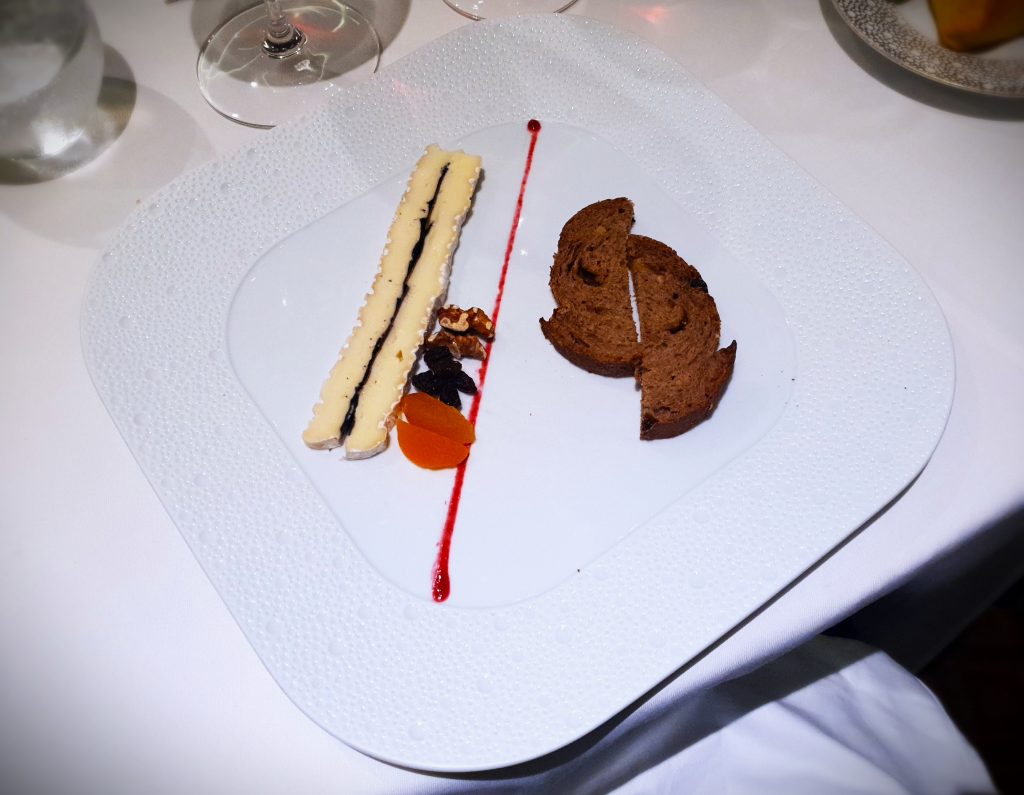 The dessert course was a Biscuit Dacquoise et Crème Praline: A Dacquoise biscuit with ganache and hazelnut praline. This was paired with a Domaine Labranche Laffont Moelleux from Pacherenc du Vic-Bilh in the South West of France. The dish was nicely balanced, with sweet, clean flavours, not too rich or heavy, appreciated by the members at the end of a long and large meal. The libation a divine dessert wine from the Pyrenees, made from the varieties Gros Manseng and Petit Manseng, showing layers of apricot, Meyer lemon, mandarin rind, and ripe mango fruit, with a nice clean finish, this was a well-balanced late harvest wine, a perfect coda to an exceptional line up of wines throughout the evening.
The dessert course was a Biscuit Dacquoise et Crème Praline: A Dacquoise biscuit with ganache and hazelnut praline. This was paired with a Domaine Labranche Laffont Moelleux from Pacherenc du Vic-Bilh in the South West of France. The dish was nicely balanced, with sweet, clean flavours, not too rich or heavy, appreciated by the members at the end of a long and large meal. The libation a divine dessert wine from the Pyrenees, made from the varieties Gros Manseng and Petit Manseng, showing layers of apricot, Meyer lemon, mandarin rind, and ripe mango fruit, with a nice clean finish, this was a well-balanced late harvest wine, a perfect coda to an exceptional line up of wines throughout the evening.
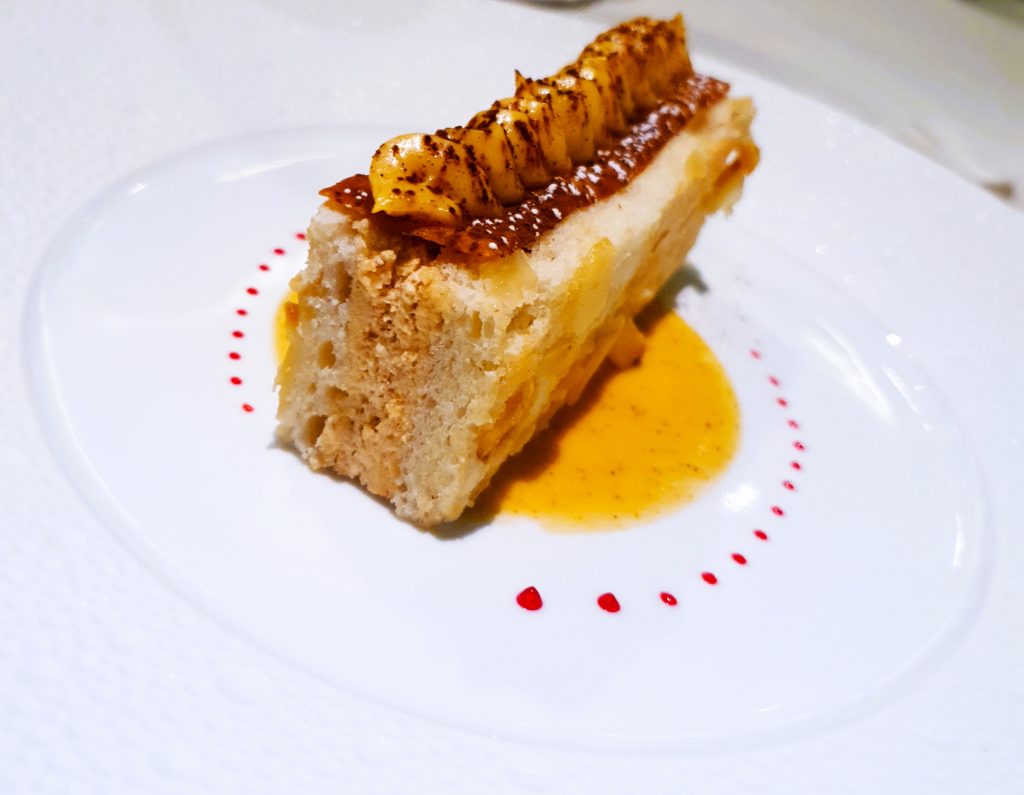 Then it was time for tea or coffee and a digestive, a superb Chateau du Briell Fine Calvados from Normandie.
Then it was time for tea or coffee and a digestive, a superb Chateau du Briell Fine Calvados from Normandie.
The Calvados was a revelation, bright, vibrant aromas of green apples and Anjou pears with a hint of baking spices and sweet pastry, the palate showed impressive poise and elegance with seductive length and a retro-olfaction sensation of clean, pure, orchard fruit. This has many members waiving their glasses around looking for an encore.
 As the evening concluded, palates sated, stomachs full, there was an unambiguous lifting of spirits throughout the room, it had been building through the evening and here guests now found themselves basking in the joy of having shared such a fine repast, such magnificent wines and smiling at each other, happy in the knowledge that they had the good fortune to have done this in each other’s company.
As the evening concluded, palates sated, stomachs full, there was an unambiguous lifting of spirits throughout the room, it had been building through the evening and here guests now found themselves basking in the joy of having shared such a fine repast, such magnificent wines and smiling at each other, happy in the knowledge that they had the good fortune to have done this in each other’s company.
Topaz is a jewel and on this night it shone most brightly, a standard-bearer for French cuisine and hospitality internationally, this had been an event to remember and the guests all knew that they would recall this evening, this meal, this time with great admiration and humble appreciation for a long, long time to come.
 I thank the Beefsteak and Burgundy Club’s own website for detailed information and copy on their history: https://www.bsb.org.au/about-us/history/
I thank the Beefsteak and Burgundy Club’s own website for detailed information and copy on their history: https://www.bsb.org.au/about-us/history/

